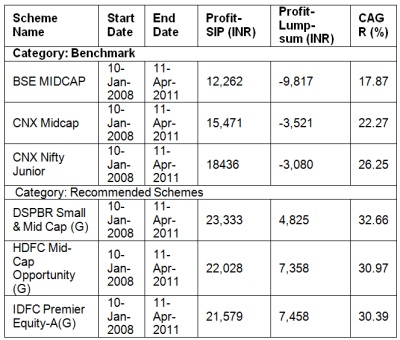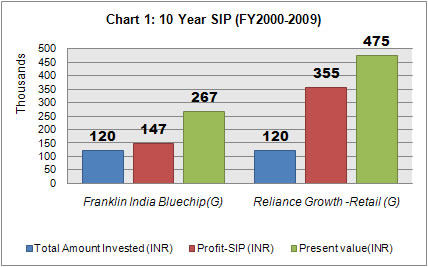Novice investors should try and avoid the four traps discussed in the article.
Despite the advantages of SIP, it may happen that SIP may not reap the desired fruits.
The situations that one can and should avoid are:
Scenario I: Abrupt withdrawal during the SIP period
If you are investing in SIP with a time horizon of approximately one year, and require cash intermittently from the investment, then the returns may not be attractive.
Example: We calculated the returns from our recommended, HDFC Midcap Opportunity Fund for a period of one year and compared it with the benchmark, BSE Midcap Index for the same period. In 2010, the mid-cap sector had a good run before correcting sharply towards the end of the year. A 12-month SIP beginning on 10 January 2010 gave a return of 2.06% as against the benchmark performance of 0.67%, at the end of all installment payments.
Even though the SIP has outperformed the benchmark by a decent margin, the returns are not substantial. Hence, one should set up SIP and hold it for long term as any other equity investment.
Therefore, plan out your cash flow requirements and accordingly, set aside an amount that you could support even as you may have other liabilities or contingencies.
Scenario II: Terminating SIP when the markets tank
The mutual fund industry witnessed numerous SIP termination requests from retail investors during the 2008 financial crisis. The principle for investing in SIP is to invest regularly and not to time the market.
Example: We looked at the performance of SIPs started from 2008 and evaluated their performance over the last 4 periods. From the peak of 2008, the Indian equities tumbled down and later recovered in 2009. Thereafter, markets witnessed steady returns until inflation and expensive valuations resulted in the market fall. If one had stayed through the market crash and invested regularly, the return from SIP would be significantly better than one time investment.
Table 1 compares the corpus generated by putting Rs. 1000 every month through SIP and Lump-sum investing.

Clearly, the SIP investors have gained more. Hence, market corrections should be looked upon as investing opportunities.
Scenario III: Investing for short term - Attracts tax and volatility
In your financial plan, the SIP should be aligned to medium to long-term objectives. One can also take exposure to high beta sectors or themes such as energy, metals, and infrastructure – power through the SIP route. This way, you can get a marginal allocation to sectors or themes that may be otherwise quite risky.
Silver delivered almost 80% returns in 2010 but, tanked by 28% in a week’s time (ending 5 May 2011). Thus, investing for short-term may not give you the benefit of averaging out the volatility which is inherent in the markets. Also, the return from high risk securities is highly uncertain during the short phases.
Moreover, you will also attract a short-term capital gains tax of 15% which is applicable for an equity holding of less than a year. Paying a tax on marginal returns would further reduce your end returns.
Scenario IV: SIP in a rising market
The concept of Rupee Cost Averaging will not work in a rising market. This is because the NAV would be on an upward trend on a month-on-month basis. So, the cost of investment would increase with every monthly installment.
During periods of secular Bull Run, investors can consider current valuation vis-à-vis other asset classes or countries, evaluate future prospects and take a call based on their risk appetite and time horizon. Accordingly, they can diversify into other assets which have a low correlation to equities like fixed income.
In contrast, when markets correct and valuations are at attractive levels, aggressive investors should opt for top-ups and increase their allocation towards fairly valued assets.
Conclusion

We can never guesstimate from a given point, whether the market would keep rising, remain range bound or fall. However, SIP remains the simplest tool towards long-term wealth creation.
Chart 1 emphasizes the multi-fold increase in assets from the SIPs of INR 1000, started in April 1999 till March 2009, across 120 installments. We have considered a large cap fund - Franklin India Bluechip Fund anda mid cap fund - Reliance Growth Fund which have grown to around INR 267,000 and INR 475,000 (till date) respectively.
Even though the markets are currently trading at low levels compared to the recent peaks, the return from a ten year investment perspective is enormous. Both these funds have given a CAGR of 17.51% and 31.97% respectively. By end of April 2011, these SIP investments have almost doubled and quadrupled.
Thus, novice investors should try and avoid the four traps discussed above and be happy investing!





